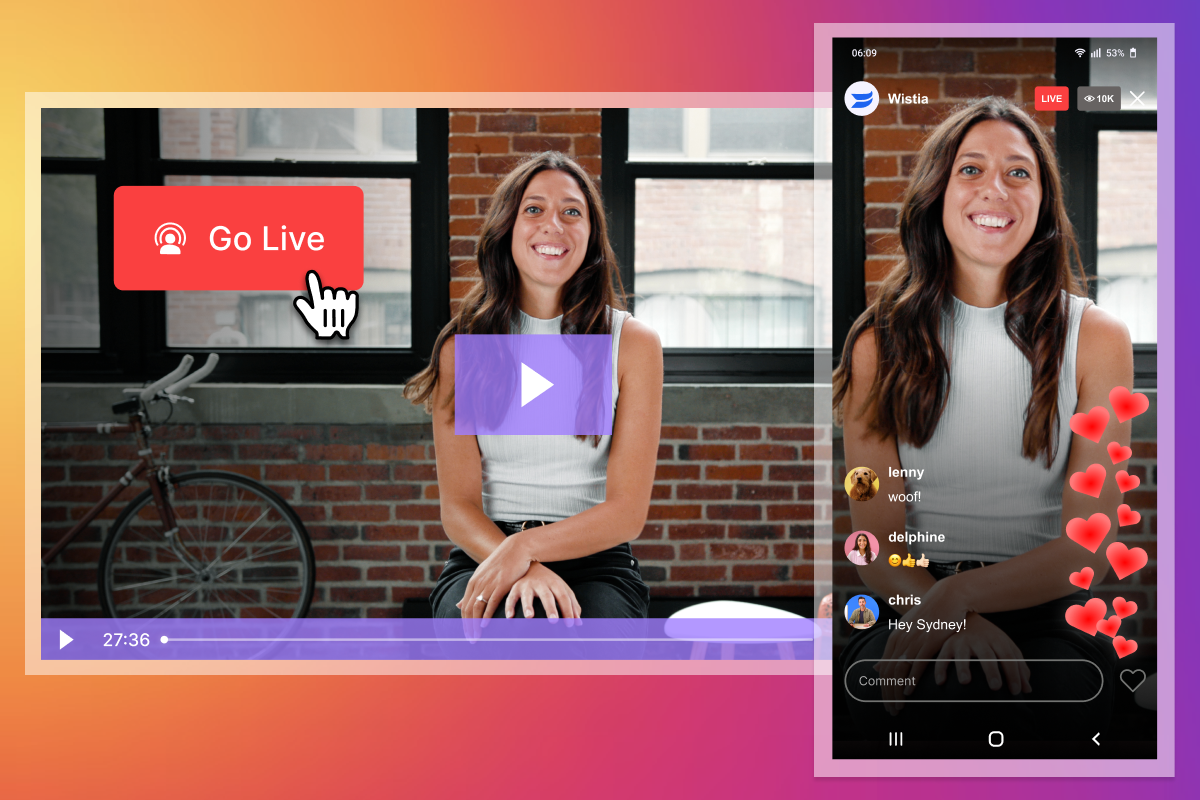6 Reasons Why You Shouldn’t Have an Autoplaying Homepage Video
October 18, 2016
Topic tags
Phil Nottingham
Marketing
Over the past few years, there’s been an increasing trend of businesses using autoplaying videos on their homepages. For many, this may seem like a novel and innovative design element – something that will make your site stand out from the crowd. Unfortunately, this approach usually causes more harm than good, and should therefore be avoided.
If you agree, please feel free to read the rest of this post feeling comfortably smug. If you disagree, I invite you to read through the arguments and evidence below, and offer a rebuttal in the comments.
If you’d prefer to watch me rant about this topic, you can press play on the following video:
1. It slows down a page that needs to be speedy
Your homepage is almost certainly your top landing page (both from referrals and organic search), which means it’s also the place many users will experience your website for the first time.
As we know, first impressions matter. In a world where 57% of online shoppers supposedly abandon a page after 3 seconds of load time, and slow pages tend to rank worse in google search (particularly on mobile searches), you really can’t afford to have a sluggish homepage.
An autoplaying video, at full bleed, is very bandwidth-intensive. A 30-second video will probably add about 10 megabytes to the size of a simple image and text-based HTML page, which can potentially quadruple the amount of data that needs to be loaded for the page to render correctly. If a user is on a weak connection (e.g. using mobile data or accessing public wifi), this can add several seconds of delay.
“An autoplaying video, at full bleed, is very bandwidth-intensive.”
While an autoplaying homepage video may seem like an exciting way to kick off the user journey, it often comes at the expense of losing large swathes of users who simply can’t load the page in time. It is likely a sacrifice not worth making.
2. Slow loading is problematic, even if you use an asynchronous embed
Yes, it’s true that if you load your video asynchronously (e.g. by using the Wistia standard embed), you won’t negatively impact the load time of the core elements on your page.
But this approach can create other issues. Take, for example, the autoplaying video on the homepage of toggl.com, a company offering time tracking software.
This is what the page looks like once the video is loaded:
But here is what the page looks like during the 3–5 seconds while that video loads on a 10 megabits per second connection:
There’s not much to write home about.
The thing is, I love Toggl. It’s a great product. And I actually really like the video on their homepage. The problem isn’t the content or the medium. It’s simply that the homepage isn’t the right place for it. If my first impression of a brand is 5 seconds of mostly greyed-out background, chances are things aren’t going to get off to a great start.
Instead, having the same video on a deeper, product overview page would make a lot more sense, since users at this stage of the customer journey are likely to have understood what the brand is about, and expressed a greater interest in finding out more about the product being offered.
3. It creates, rather than lessens, cognitive load
There’s a principle in psychology called cognitive load, which basically means the amount of mental effort required to accomplish a specific task (analogous to the processing power in computers).
Good user experience rests on reducing the cognitive load of your users. Your visitors should be able to complete the actions they want to achieve in a frictionless, stress-free manner.
“Good user experience rests on reducing the cognitive load of your users.”
It’s for this reason that we tend to enjoy using simple, intuitive user-interfaces like Gmail, and why self checkout machines reciting the words “unexpected item in bagging area” on repeat fill most of us with a deep sense of rage and violent thoughts.
Including an autoplaying video on a homepage can often increase, rather than reduce, cognitive load. Putting lots of flashing images in the background makes it harder for your brain to locate and choose the relevant links, thus adding a great deal of mental effort to complete an otherwise simple task.
Want to see this principle in action?
Check out the video on the homepage below from Wibbitz - an exciting new video production platform I discovered recently. The homepage has two lines of text, a small number of links in the top navigation bar, and a nicely implemented call to action.
On the face of it, this should be a very simple page to navigate. However, observe how difficult it is to read and process the words and CTA on the page with a fast-paced video going on in the background.
4. It makes watching a video the main CTA
Few companies measure the value of a homepage based on whether or not a user successfully watches a video. The goal of most homepages is to send users to deeper pages in the funnel, in an effort to get people to complete an action.
Let’s say for example, that the action you really want people to take on your homepage is to click through to a sign-up page. Instead of encouraging this action by simplifying the page and lowering the cognitive load, you decide to add an autoplaying video, because … it looks cool, so why not?!
What you may not realize is that you’re probably encouraging users to sit there and watch said video, only permitting them to commit to the CTA after the video is complete. This adds an unnecessary step (and mental effort) into the conversion funnel, which can inadvertently increase the bounce-rate, reduce click-throughs, and make your homepage seem like an advertisement, rather than, well, a homepage.
5. It didn’t work that well for Wistia
There are some compelling numbers from Wistia’s experimentation with autoplaying homepage videos that support the conclusion that they’re really not that great.
Two years ago, Wistia’s homepage looked like this:
Results with no autoplaying video:
- 53% increase in organic traffic to the homepage
- 7% increase in sign-ups
- 4% improvement in exit rate
While it’s entirely conceivable that Brendan’s face alone put off both prospective customers and Google search robots, I think it’s likely there were other factors at play.
The video-based homepage was thin on text. Moving to a more traditional, text-heavy HTML format meant that the page could rank for more terms on Google search, thus appearing “richer” to Google algorithms and resulting in better ranking for competitive queries.
Additionally, the decision to change the main CTA from watching a video to encouraging users to visit another page and begin the process of signing up for an account, likely also helped conversions.
6. It makes a homepage not a homepage
What’s the point of a homepage? Well, in the majority of cases, it serves as the primary landing page for all site traffic - an entrance, if you will.
A homepage is therefore fairly analogous to a main entrance of a building. The purpose of said entrance is to get people into the building, and then send them off as efficiently as possible in the direction of their choice. Online, the goal is to take that traffic and direct it to the most appropriate next page as efficiently and speedily as possible.
Video typically works against this goal. Just as you wouldn’t want to enter a shopping mall and immediately watch a video explaining the concept of the mall, demanding that your audience watch a video before navigating to their next page won’t provide a delightful user experience.
The exception to the rule
Autoplaying homepage videos, while they’re mostly bad in my view, do have some hope …
When they’re hardly videos at all.
Allow me to explain. Videos which are essentially just slow-moving images (e.g. somewhere between a static image and a video) can work well, but only when they do not distract the user’s peripheral and focal attention away from the CTA.
The idea is to allow the eye to rest on the main CTA before it can become distracted by other, less relevant information. Sites that accomplish this can in fact add a level of emotional and visual richness to the overall user experience with video.
“The idea is to allow the eye to rest on the main CTA before it can become distracted by other, less relevant information.”
If such videos can be implemented in a way that doesn’t negatively affect load time or click-through rate, then they can potentially enhance the value of the experience.
Stay skeptical
Video can be a wonderful addition to your website design and marketing, but like all creative page elements, the context in which it is deployed is critical. In my view, the appropriate context is very rarely the homepage.
Rather than demanding an absolute moratorium on autoplaying homepage videos, I simply want to flag the often overlooked problems and risks associated with this tactic, in order that UX and marketing professionals can approach this with a healthy degree of skepticism.
As always, you should split test any changes to your homepage both from a conversion standpoint (with something like Optimizely) and from an SEO standpoint (with something like Distilled ODN), before committing wholesale to big changes that could potentially have a wide-ranging negative impact.







